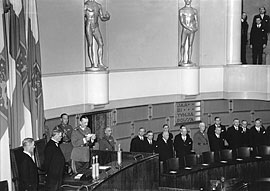The President of the Republic of Finland: Position and Duties: Election of the President
Election of the President
The President of the Republic is elected by direct popular vote. In the regular course of events, a Presidential election takes place every six years.
If the incumbent dies or becomes permanently incapacitated, a new President is elected as soon as possible.
Eligibility and term of office
The President must be a native-born citizen of Finland. The term of office is six years. The same person may be elected President only for two consecutive terms.
Candidates
A registered party that has received at least one seat in the preceding parliamentary election may nominate a Presidential candidate. A candidate may also be nominated by 20,000 enfranchised citizens, who have established a constituency association.
Election
The first round of balloting takes place on the fourth Sunday of January in the election year. If one of the candidates receives more than half of the votes cast (50% + one), he or she is elected President. Otherwise, a second round between the two candidates who have done best in the first round takes place two weeks later. The candidate who then receives most votes is elected. In the event of a tie, the election is resolved by lot. The Government confirms the outcome of the election and, if necessary, conducts the drawing of lots.
If only one candidate is nominated, he or she becomes President without an election.
Inauguration
The President-elect assumes office on the first day of the month following the election by making the following solemn affirmation at a ceremony before Parliament:
"I, N.N., whom the people of Finland have elected President of the Republic of Finland, affirm that in the execution of my office as President I shall sincerely and faithfully observe the Constitution and laws of the Republic and to the best of my ability promote the success of the Finnish people."
A President chosen in a premature election assumes office and makes the solemn affirmation on the third day after having been declared elected. The term of the President-elect begins and that of the predecessor ends at the moment the solemn affirmation has been made.
Presidential elections 1919 - 1988
Earlier electoral procedures
Presidents were elected indirectly in the period 1919 – 1987. The first stage of the process was the election of 300 (301 in 1982 and 1988) electors by popular vote. They then elected the President, without being bound to support any of the persons who had announced their candidacy. There were no legal provisions concerning candidates; indeed, the legislation did not even mention them. The electors chose the President in 1925, 1931, 1937, 1940, 1943, 1950, 1956, 1962, 1968, 1978, 1982 and 1988.
A new two-stage method of election was introduced under legislation enacted in 1987, but it was used only once, in 1988. In the first stage the electorate voted for the officially nominated Presidential candidates and also at the same time chose the 301 members of an electoral college, who would elect the President in the event of none of the candidates obtaining more than half (50% + 1) of the votes in the popular ballot. President Koivisto did not obtain more than half of the votes in the popular ballot in 1988 and was chosen by the electors.
The present electoral method was introduced under legislation enacted in 1991 and first used in 1994. The electors chosen in 1937 elected Presidents on three occasions: in 1937, 1940 and 1943. That was because it was not considered possible to arrange elections for electoral colleges in the exceptional circumstances of 1940 and 1943.
Exceptional procedures
 Exceptional procedures were followed in the Presidential elections of 1919, 1940, 1943, 1944, 1946, 1973 and 1982.
Exceptional procedures were followed in the Presidential elections of 1919, 1940, 1943, 1944, 1946, 1973 and 1982.
The new Constitution of Finland authorised Parliament to elect the first President, and in 1919 it chose K.J. Ståhlberg. In 1944 special legislation directly stipulated Marshal Mannerheim President for six years after Risto Ryti had resigned mid-term.
In 1946, further exceptive legislation empowered Parliament to choose a successor for the remainder of Mannerheim’s term (until 1.3.1950), the latter having resigned. Parliament then chose Prime Minister J.K. Paasikivi for the post. In 1973, special legislation extended President Urho Kekkonen’s term by four years (until 1.3.1978).
The elections of 1940 and 1943 were likewise exceptional in that they were performed by the electoral college chosen in 1937. The 1940 election, necessitated by President Kyösti Kallio’s resignation, was also premature and the new President was chosen only for the remainder of Kallio’s term rather than for the full six years. The elections of 1944, 1946 and 1982 were likewise premature, resulting from the resignation of an incumbent.
* * *
 Election statistics (pdf document 53 kb)
Election statistics (pdf document 53 kb)
About this site webmaster[at]tpk.fi



